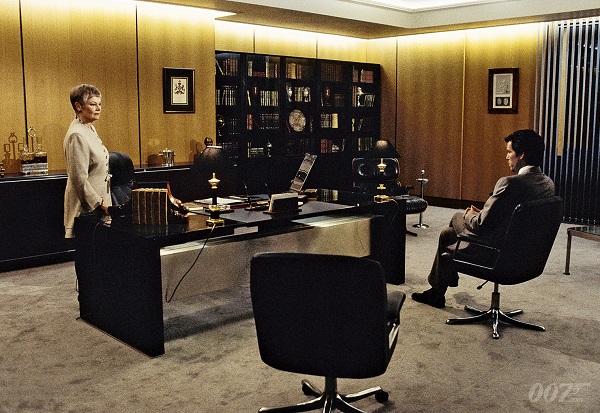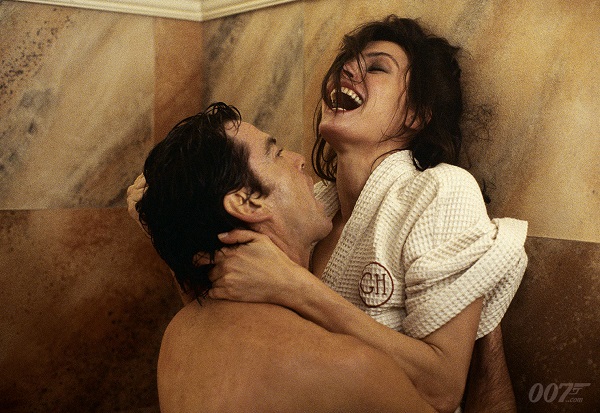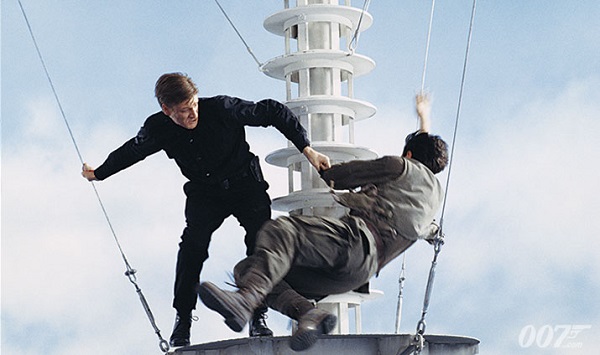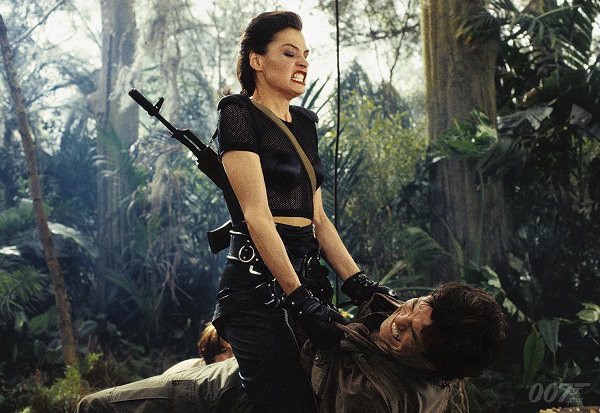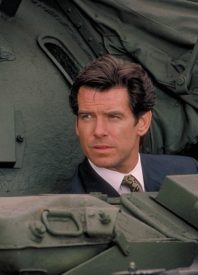
“Beg your pardon. Forgot to knock.”
The film began with Eric Serra’s moody synth take on a James Bond score. Composer John Altman came aboard for one sequence, listed on the soundtrack as A Pleasant Drive In St. Petersburg. This music plays more familiarly for the audience. Nonetheless, it’s obvious that James Bond’s return to the screen would be something new and different. The legal disputes finally settled, and the longest break between 007 films since they went into production ended. Then, GoldenEye, named for Ian Flening’s home in Jamaica, was prepped for the big screen.
Albert ‘Cubby’ Broccoli stepped down from his role as producer after Licence To Kill. He let his daughter, Barbara and now stepson, Micheal G. Wilson take over to helm the film franchise. In fact, the film very much represents a change in the old guard both in front of and behind the camera.
Peter Lamont stayed on as production designer, Syd Cain returned to help design weapons and gadgets. And Derek Meddings oversaw the miniature effects. But for a director they went outside the 007 pool and recruited New Zealand director Martin Campbell. He had just finished a small sci-fi action film called No Escape.
Featuring a story by Micheal France, this is the first film in the series not to use any elements previously created by Fleming. Instead, a story was transformed into the screenplay by Jeffrey Caine and Bruce Fierstein. The film showcased beautiful costume designs by Lindy Hemming all shot by the DOP, Phil Meheux, and cut by Terry Rawlings.
Pierce Brosnan’s name was touted by fans around the world. So the creative team heading the James Bond franchise got him to step into 007’s tuxedo. And he brought an all-star cast to help him launch his take on the character. Judi Dench assumes the role of Bond’s boss, M., who has little use for the man. Sean Bean plays the film’s villain, 006, Alex Trevelyan. Izabella Scorupco plays a Russian programmer caught up in the film’s events. Famke Janssen delivers an over the top performance as Trevelyan’s right hand, Xenia Onatopp. Robbie Coltrane plays a crime boss, Valentin. Alan Cumming and Tcheky Karyo make appearances. And Joe Don Baker, last seen in The Living Daylights, plays CIA operative Jack Wade.
At the MI6 offices, the beloved Desmond Llewelyn returns as Q, the appropriately names Samantha Bond is the new Moneypenny. Micheal Kitchen begins a recurring role as Bill Tanner, an MI6 staffer, and one of Bond’s best friends from the novels.
The story finds 007 and 006 going head to head after an explosive opening sequence that holds the world in the balance. It’s probably one of the most personal arcs for James Bond in the film series since the death of Tracy, and the hunt for Blofeld.
And just to prove this was the biggest Bond to date, the production took over an abandoned Rolls Royce factory. Under Lamont’s eye, it was transformed into a new film studio, Leavesden. The production, as per usual, also included lots of exotic locales, such as Puerto Rico, Switzerland, France, Russia, Monaco, and of course the UK.
While Bond does have his gadgets in this film, he doesn’t tend to use them at a deus ex machina. He uses them at minor points. These gadgets augment tense sequences, but the final confrontations always left Bond to rely on his wits and abilities. This allowed the film to embrace the darker edge action films were embracing while still sticking to the tried and true formula of the 007 films.
Brosnan settles easily into the role, and seems to be having a great time. He looks goodly behind the wheel of the Aston Martin DB5 (as well as a BMW Z3 – the first in a new association the franchise created with BMW). But importantly, Bond finally returns to the screen, carrying the film itself. It’s like he’s finally come home and is intent on enjoying ever moment of it.
It’s a big film with standout sequences and set pieces. The pre-credits sequence has two stunning stunts to launch the film. Those include the free-fall behind an airplane done by parachutist Jacques Malnuit. There’s also Wayne Micheal’s record setting bungee jump off the Verzsaca dam. There’s a brilliant tank chase through the streets of St. Petersburg (actually a Lamont set at Leavesden), a shootout and escape from a Russian research center. And there’s a bone-crunching showdown between 006 and 007 at the film’s climax. It featured almost no stuntmen and was done by Bean and Brosnan themselves.
With this film, Brosnan cemented an opinion already held by the world, he was 007. He could be charming, unflappable, disarming, funny, and be believable in a fight and action sequence. The film makers embraced the iconic tropes of the Bond films. The look, the car, the locations, the gadgets, and reinvented it for a new generation of film-goers, and longstanding fans.
U2’s Bono and The Edge penned the film’s theme song, which was belted out by the one and only Tina Turner. Meanwhile Serra’s score, a little odd and synthetic sounding, works, but reminds us that this is a different Bond. It also did not incorporate any of the film’s theme into the score. But it did tell us that this was a Bond that would take us right to the edge. And what would the theme song be without a titles sequence to promote it? After Maurice Binder’s passing in 1991, Daniel Kleinman took those over. He carried on the tradition of the female silhouettes and figures set against images of Bond and thematic components of the film.
Goldeneye had a release date of 17 November, 1995 in North America, and 21 November in the UK. And the studio generated pre-release excitement with a pair of teaser trailers that highlighted the new Bond. To create a poster the creative team turned to photographers Terry O’Neill, Keith Hamshere and George Whitear. They worked under the art direction of Earl Klasky and Randi Braun. They create the tease and release posters – gone are the day of painting, and the reign of Photoshop rears its head again. The poster is sharp, gorgeous, and conveys the feel of the film on all levels, but I miss the days of movie posters being the realm of painted artwork.
All of a sudden James Bond was everywhere again, and nowhere was he more successful than on the Nintendo64 gaming platform. They made a video game, based on the film, and it featured multiplayer showdowns with fantastic unlockables. And it proved to be one of the most iconic games of all time.
At the box office, Brosnan and Bond proved golden when the film became the most financially successful in the franchise since Moonraker. It showed that it was totally worth the wait to have Brosnan take over the role. It brilliantly suited his acting style. And fans could relax knowing he’d signed a multi-picture deal. And even if they didn’t know, they could take solace at something at the end of the film. It featured a horrendous closing song by Eric Serra, The Experience of Love, but it told fans that James Bond Will Return.
Thank you to my own personal Q Branch, DK Canada for equipping me with all manner of information for these posts. This includes James Bond: 50 Years of Movie Posters, Bond By Design: The Art of The James Bond Films, and The James Bond Encyclopedia.

